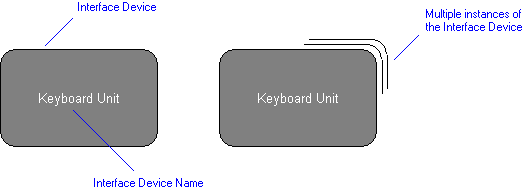


 on the Interface Device's icon indicates that the item is a
stub.
on the Interface Device's icon indicates that the item is a
stub. Dependency —The Dependency is owned jointly by the Interface Device and the other associated item. The access permissions you have to a Dependency are determined by the access permissions of the dependent item.
Dependency —The Dependency is owned jointly by the Interface Device and the other associated item. The access permissions you have to a Dependency are determined by the access permissions of the dependent item. Drop —The Drop is owned jointly by the Interface Device and the associated Multidrop Bus. The access permissions you have to a Drop are determined by the access permissions you have to the source item.
Drop —The Drop is owned jointly by the Interface Device and the associated Multidrop Bus. The access permissions you have to a Drop are determined by the access permissions you have to the source item. External Connector —The External Connector is owned jointly by the Interface Device and the associated Actor. The access permissions you have to an External Connector are determined by the access permissions you have to the source item.
External Connector —The External Connector is owned jointly by the Interface Device and the associated Actor. The access permissions you have to an External Connector are determined by the access permissions you have to the source item. Point-to-point Connection —The Point-to-point Connection is owned jointly by the Interface Device and the associated item. The access permissions you have to a Point to Point Connection are determined by the access permissions you have to the source item.
Point-to-point Connection —The Point-to-point Connection is owned jointly by the Interface Device and the associated item. The access permissions you have to a Point to Point Connection are determined by the access permissions you have to the source item. Interface Device Type —The linked Interface Device Type specifies technical features of the Interface Device.
Interface Device Type —The linked Interface Device Type specifies technical features of the Interface Device. Subsystem —Note that an interface Device cannot be linked to both a Package and a Subsystem.
Subsystem —Note that an interface Device cannot be linked to both a Package and a Subsystem.Like most other items in a Model, an Interface Device can be linked to an
Activity Partition,
Comment,
Frame Box,
General Node,
General Flow,
General Flow Diagram Node,
Constraint (applied),
General Flow Diagram Flow or
Swimlane. |